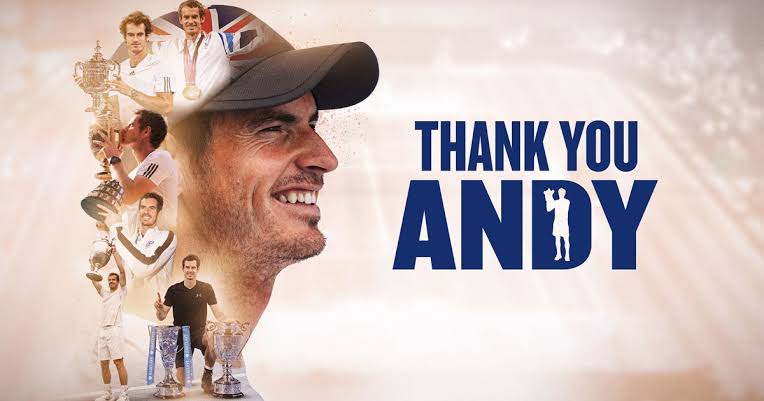Andy Murray Retirement Tribute

Andy Murray: A Man for All People
by Neil Edward Schlecht
The Scottish legend Andy Murray may not have ended his career exactly the way he wanted – playing singles on the lawns at Wimbledon, where he won The Championships twice – but he did bow out in the most Murrayesque manner imaginable. Playing doubles in the Olympics for Great Britain, the two-time gold medalist teamed up with compatriot Daniel Evans and won their first match, storming back from a 9/4 deficit in the Match Tie-break and saving five straight match points to snatch victory. He and Evans also survived two match points in the next round before losing in the quarters. After both wins, the former World No. 1 celebrated as though he had just won the gold medal – leaving it abundantly clear just how much the game always meant to the Scot.
In May 2019, Andy Murray knelt before Prince (now King) Charles, who touched a gilded sword to each of the Scot’s shoulders and officially conferred knighthood upon him at Buckingham Palace. Murray was knighted in recognition of his career as a professional tennis player, which included reaching No. 1 in the world, winning three major championships – Wimbledon twice and the US Open once – and becoming the only player male or female to win two Olympic gold medals in singles, back-to-back.
From that moment, the Scot was no longer just Andy, or Muzza, as many Brits were fond of calling him. He became Sir Andy Murray for returning sporting glory to the onetime tennis empire Great Britain. When he captured the Wimbledon crown in 2013, Murray ended a 77-year British drought at The Championships: Fred Perry had been the last British man to win, in 1936.
In the eyes of many in the UK, Murray’s triumph at Wimbledon ranks as the greatest sporting event in modern British history.
Sir Andy scaled uncommon heights in a long, illustrious career – one that had every indication it would end much earlier than it did (more on that later). As the last of the so-called Big Four, Murray was really the only player to regularly challenge the major- and Masters-dominating trio of Novak Djokovic, Rafael Nadal, and Roger Federer – the greatest era in the history of men’s tennis.
Yet as clearly the fourth member of that group – at this stage tennis insiders mostly reference the Big 3, really – Murray perpetually had one foot in the game’s greatest ruling elite and the other just at its doorstop. Even more so than his rivals, Murray’s career was riddled with hardship and setbacks. His struggles to shoulder the pressure of an entire nation, and play through a litany of injuries and surgeries, ultimately transformed the Scot in the eyes of the public.
Emerging from unlikely origins, coached by his mum in smalltown Scotland on his way to becoming a global superstar, Murray remained grounded – a man of the people. Both the elites of the All England Lawn Tennis Club in Wimbledon and the commoners who waited in long queues just to get into the grounds became diehard fans. Murray’s challenges were apparent to all, and he made no effort to hide them. The Scot, who rarely backed down on court, never feared being outspoken on issues of fairness and equality both in tennis and society. Especially late in his career, Murray thrived on pure will and determination, extending his career deep into his late 30s despite playing with a metal hip.
But like everything Murray did, getting to that stage was a process.
The duality of Murray
The Scot could be petulant and irascible on court but high-minded off. “Andy is complex,” his former coach Amélie Mauresmo said. “On the court, he can be the opposite of what he is in life.” His game was similarly demarcated, with a unique high/low ethos.
Murray labored sullenly about the baseline, barked incessantly at his team and for much of his career looked genuinely surly during matches. His nickname, Muzza, suited both his game and on-court persona. The Scot seemed like the gruff, opinionated guy you might find on a barstool at the local pub.
And while his tennis was as scruffy as his perpetually unshaven chin – scrappier and less ethereal than the tennis skill sets of Federer, Nadal and Djokovic – Murray had one of the finest returns and smoothest and most effective two-handed backhands the game had ever seen. He was capable of sublime tennis. When the strategic moment called for it, he would lift a deft lob — the best in the business — or carve a delicately angled backhand cross short in the court.
But the Scot, a natural counterpuncher, really made his living off of drop shots, dinks, slices, lobs and off-speed balls. Though 6-foot-3, broad shouldered and fleet of foot, Murray rarely dazzled with fluid athletic artistry or displays of easy, graceful power.
More often than not, Murray was content to lull his opponents into bad patterns, force them to deal with junk, and look to outsmart or outlast them. Even if he was content to play possum, patiently waiting to pounce, his approach wasn’t stubbornness. Murray at his finest was a tactician. Defence-minded, he reacted to other players’ blunt punches. The rap on the strapping Scot, though, was that he could push that strategy too far and become curiously passive.
At his core, Murray was a street fighter. And an endurance man. Murray won 25 five-set matches at majors during his career, and he holds the record for coming back from two-sets-down to win in five sets. Murray accomplished that feat an astonishing eleven times in his career. He stormed back from a two-set deficit to win at Davis Cup, Wimbledon (twice), the US Open (four times), the French Open (three times), and the Australian Open (once). Let’s have some sympathy for poor Richard Gasquet, who twice held two-set leads over Murray at majors only to squander them.
“The one defining characteristic of the Scotsman’s phenomenal career is that he doesn’t know when he’s defeated,” wrote The Guardian.



